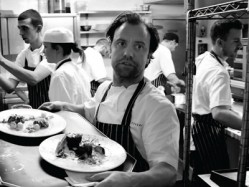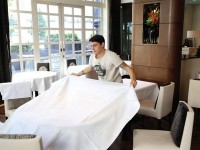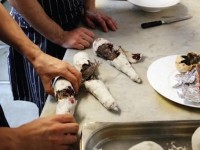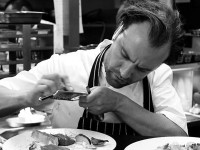A day at The Ledbury: In the kitchen of the UK's best restaurant

7.30am
The sauce chef descends the stairs and unbolts the heavy kitchen door. Above on street level this quietly affluent west London neighbourhood is beginning to stir as commuters stride toward tube stations and bus stops and a team of bin men rattles noisily down the road.
She is greeted first by a pile of deliveries: boxes of bones for stocks, bundles of obscure herbs, a selection of Berkshire venison – muntjac, roe, sika and fallow – and a motley assortment of gnarled and muddied root vegetables.
There are several reasons why Brett Graham’s Notting Hill restaurant has been ranked number one on our list of the top 100 restaurants in the UK for three years running, but the unparalleled quality of the produce is a logical place to start.
Very few chefs go to such lengths to source – and just as importantly understand – ingredients. These early-bird boxes are just the beginning. Over the course of the day a bewildering array of supplies will arrive from all corners of the UK, along with a small amount of product from the Continent.
“We are focused on UK produce but we will go abroad for a few things if necessary. Good farmed pigeon isn’t produced here so we look to France for that, but we don’t see the point in going anywhere else for game as nowhere is better than the UK,“ says Australia-born Graham, whose restaurant was also the highest climber on our list of the World’s 50 Best Restaurants earlier this year.
8am
The kitchen porter arrives, switches on warewashers and helps to stow deliveries which are now arriving in earnest, while prepping down some ingredients straight away to relieve pressure on the kitchen’s limited fridge space. Upstairs the cleaner starts work on the dining room: floors vacuumed, mirrors polished and toilets cleaned.
Freshly showered and a little bleary-eyed, the rest of the brigade start to file in and pick up prep lists from the previous night. The Ledbury kitchen is not a land of pressed chef’s whites and freshly starched toques. Its inhabitants favour a more individual sartorial approach: well-worn whites of various origin – a couple apparently on loan from another London restaurant of some repute – navy striped aprons, singed glass cloths for handling hot pans and trays and plate-polishing towels safely tucked away between whites and apron.
The Ledbury kitchen mirrors its chargers: clean and organised? Absolutely. But the cramped, windowless space is not the sleek, consultant-designed affair that is the norm at two-star level. The top-end stove is scarred and beaten, and everything else clearly well-used. The kitchen has the look of somewhere that has gradually expanded over time: new bits of kit have clearly been squeezed in as the acclaimed restaurant got busier and the food evolved.
9am
Front-of-house (FOH) staff start arriving, check their stations and begin to set up the dining room. The receptionist arrives and the booking line opens. Reservations start coming in straight away.
The Ledbury is one of the few restaurants at its level not to engage the services of a public relations agency. With the dining room’s 60 covers consistently full in the evenings and – more unusually – at lunchtimes, Graham sees little point.
Such an approach also fits in with his comparatively low-key persona. Though well-known within the industry and a friendly and ebullient character in person, Graham on the whole avoids consumer media opportunities.
“I don’t chase press coverage and I’m suspicious of PR. I’d rather put my resources into retaining my existing customers. If I can keep those I don’t need many new ones,” he says.
Aside from menu input at The Harwood Arms – the Fulham gastropub he co-owns with Mike Robinson of the Pot Kiln pub in rural Berkshire and Edwin Vaux from the Vaux Brewery family – Graham doesn’t really do distractions. “This restaurant has to be my main focus. This is where I cook. I normally do between nine and 10 services a week. Running around opening other restaurants and pubs won’t allow The Ledbury to reach its full potential.”
Backed by his previous employers – chef Philip Howard and restaurateur Nigel Platts-Martin, co-owners of The Square in Mayfair – Graham launched The Ledbury in 2005. Over the past seven years, he and his team have carved out an impressive network of niche and unusual suppliers.
A lot of City-based chefs are guilty of being detached from the products they serve. They pick up the phone and order without thinking about where the produce comes from,” says the 32-year-old. “We interact with our suppliers and communicate to them exactly what we want.”
What the team want can be quite nuanced. Things won’t just be sent back for being off or damaged. Everything is rigorously examined and tasted and if it’s not right it goes back. “This encourages suppliers to only send us the very best,” continues Graham. “I try not to push people into giving me things that aren’t right; I’d rather change a garnish or take a dish off. I’m not very rigid when it comes to menus and dishes.”
10am
Prep period shifts up a gear as chefs push to get mise en place ready for service. Graham and sous chef Greg Austin go through the day’s dishes with staff and assist with prep work where needed. General manager Stephen Quinn and head sommelier Anja Brieg arrive.
The Ledbury is a tough kitchen but not in the macho, quasi-military manner of many top-end establishments. Perhaps it’s the Antipodean vibe – Austin and some others in the brigade also hail from Australia and New Zealand – but the frantic rush to get ready for a fully booked lunch service feels like a collaborative effort.
“This is a not a laid-back kitchen; we can’t have people who don’t pull their weight, but we try and encourage teamwork,” explains Graham. “In many places at this level there is a culture of not helping people when they’re in the shit, but we come to people’s aid here where possible.”
As Graham and Austin check each section it becomes clear they practice what they preach. Both muck in where needed: Austin breaks down a side of venison into its constituent cuts and Graham assists the vegetable section.
There is little bravado in the kitchen, an observation reinforced by the presence of no fewer than three female chefs de partie, one on the notoriously tough sauce section. Aside from stagiaires and students, Graham doesn’t employ any chefs below chef de partie status. “If they can’t run a section they’re not ready for this kitchen. I don’t see the point of commis chefs at this level.”
11am
Staff meal (Welsh rarebit with ham and salad) is dished up and a big batch of filter coffee is brewed. All staff eat on the hoof. There’s simply no time to relax, and one also gets the feeling that a five-minute sit-down would break the team’s focus. The energy levels in the kitchen are nothing short of extraordinary. There is a healthy amount of work-related conversation and general banter, but it’s all conducted while working at great pace – the idea of pausing to chat seems an impossibility here.
Graham is working on a du jour menu starter with the vegetable section chef: a plate of root vegetables with lardo di Colonnata and shaved ceps and pear. A large selection of root vegetables – beetroot, celeriac, parsnip, chervil root, parsley root, purple carrots – are being cooked individually.
An enormous, gnarly parsnip is treated with as much reverence as a leg of lamb. Roasted with herbs and butter, Graham periodically bastes it and checks progress. Vegetables with a high water content such as beetroot and celeriac are roasted in clay to draw out the moisture and concentrate the flavour. Drier vegetables such as carrots are roasted in foil to keep them moist while the parsley and chervil roots – which are very dry with tough cores – are confited in olive oil, herbs and garlic.
“Cooking the vegetables for the du jour starter is a morning’s work,” says Graham. “We could just whack all the vegetables on a tray and roast with olive oil but we like to take a moment and work out the best treatment for each one. A lot of work has gone into the growing and sourcing of these products, so we like to do them justice.”
11.30am
Prep stops and the chefs wash down their sections and sweep and mop the floor while the senior kitchen and FOH teams meet to discuss changes to the menus, special options and which regulars are booked in that day.
As usual, the restaurant is fully booked for lunch. Roughly 50 per cent of the bookings will be regulars who live or work in the area, a contingent that Graham rightly sees as the backbone of the business. “In the evening we’re a little bit more destination, but at lunch the core of the business is local. It’s very important that we look after the customers that we have,” he says. Detailed information is recorded about regulars’ likes and dislikes including preferred seats, wine preferences and food intolerances and allergies.
An interesting, regularly changing and good value lunch menu is another key to encouraging regular custom. “About half the dining room will order the lunch menu, so it needs to be as good as the à la carte and tasting menus,” says Graham. “That’s the approach we’ve used to build our lunch trade. If we’ve got beef fillet left over from the night before I’ll take a small hit and put it on the du jour. Some chefs are too thrifty with set lunch menus.”
Said beef fillet is representative of a prolonged search for a perfect expression of prime beef. “I didn’t use fillet for four years but I’ve finally found something good enough. The breed is Belted Galloway and it’s taken from the narrow end of the Châteaubriand. I find the texture gets looser as you get towards the other end of the fillet.”
Deep red with an intoxicating raw beef aroma, the fillets are sourced from a single farm in Cumbria. Supply is inconsistent because Graham is only interested in the top two to three per cent of the herd. Such is the team’s sourcing expertise, an entirely different breed of beef is selected for non-prime cuts.
Graham also seeks to offer ingredients that aren’t generally found in other restaurants. Today the kitchen will use fig leaves and English wasabi, the root, stalks and leaves. “The wasabi root is £300 per kilo but I’m happy to pay that,” he says. “It’s a brilliant product, people taking risks and producing great ingredients need to be supported.”
11.45am
Last-minute preparations such as vinaigrettes, consommés and perishable garnishes are finished and checked by the senior kitchen team. There’s a tangible change of atmosphere in the kitchen as midday approaches. Chefs start squirrelling away spare tea towels and utensils and fill tubs with hot soapy water for swift pan and hand-washing at their stations.
As the kitchen readies itself, Graham discusses the four types of venison on offer that day with Austin and Quinn. In recent years, game has become something of a personal passion for Graham, who now regularly stalks deer for the restaurant as well as shooting pheasants and partridges. Today customers will be given a choice of deer species, served with beetroot, blackberries and bone marrow as part of the tasting menu and with red leaves, vegetables, bone marrow and plums on the du jour menu.
“You can smell the differences between the species in the raw meat,” says Graham. “These are all male, and they’re good and fatty at the moment. In a few weeks they’ll start focusing on mating and that means fighting other males. They won’t be so good then, with all that energy spent. They won’t eat much when they’ve got females on their mind.”
The Ledbury largely manages to avoid the us-and-them mentality so common between kitchen and FOH teams by promoting cooperation and interaction. Graham is not above carrying trays up the stairs and he encourages his FOH team to bring a little of the kitchen into the dining room. The previously mentioned clay-clad vegetables are brought up to customers for closer inspection, as are cuts of game.
His consideration and input into FOH elements is a crucial part of The Ledbury experience and a key part of its success. Graham is a restaurateur as well as a chef and the restaurant has picked up numerous awards for the quality of its service, including our own National Restaurant Awards Front of House Award two years in a row.
Midday
The ticket machine judders into action and the first few orders are called out by Graham. The team push to clear early starter tickets and so set the pace for an efficient service.
Even under pressure, the attention to detail is impressive. The thinnest slivers of ingredients used for garnishes are carefully seasoned and dressed at the last minute. The pears used to garnish the du jour root vegetable starter are carefully brushed with truffle juice, extra virgin sesame oil and seasoned with salt.
The fish and cold starter section is taking the brunt of the pressure, with multiple starters and mains on order. An awful lot of the cooking is last minute: most kitchens would pre-boil, chill and hold lobsters, but at The Ledbury it’s all done à la minute, with the fish-section chef boiling lobsters as they come on order and handing over to a trained-up KP for disassembly.
12.30pm
Orders start coming in quickly as around 50 per cent of lunch guests are seated. Some locals are working and request to be in and out in an hour-and-a-half, which puts extra strain on the operation. Waiters gingerly navigate the awkward right angle between the pass and the stairs leading up to the dining room, their large metal trays piled high with the kitchen’s artfully presented dishes.
During service, the cooks swig chilled water from spent champagne bottles. One suspects that many a visitor to The Ledbury kitchen has left thinking that their meal was cooked by a crew of highly functioning alcoholics.
It’s ferociously hot. The range isn’t particularly big but the tightly-packed nature of the space makes the hot sections nearly unbearable for civilians. A kitchen porter passes round some more bottles of ‘champagne’.
The sauce chef is cooking quails for a dish of roast quail breast with walnut milk, ceps and pear. He’s using a waterbath, but not in the conventional manner. When the dish comes on order, the unbagged quail is warmed in the bath, which contains seasoned chicken stock, and then briefly pan-seared for colour and flavour.
Generally speaking, Graham is not a fan of waterbaths. “The standard bagged and pre-cooked approach makes the meat uniformly pink, but I think you lose an awful lot of blood and flavour to the bag so it’s not a technique we really use,” he says. While Graham is certainly no Luddite, there’s little modern gadgetry in The Ledbury kitchen aside from a top-of-the-range combi-oven for fine control over cooking temperatures. The cooking at The Ledbury is more about instinct, flavour and seasonality than technical wizardry and research –the kitchen is bold and original without resorting to avante-garde posturing. Everybody’s feet are kept on the ground by the need to keep the restaurant’s more conservative regulars happy.
“Our dishes are very simple and usually based on proven combinations. The beef dish we have on the à la carte [fillet with Cévennes onions, crispy potatoes and truffle]is just beef with potatoes and onions. We do take a bit of influence from Japan because I like the lightness,” Graham explains.
2.30pm
The majority of diners – usually numbering about 65 on a typical weekday lunch – are on to the final stages of their meals and the pace in the kitchen starts to slow. Some chefs move over to prep duties while junior FOH staff furiously polish glasses and cutlery downstairs.
During service, Graham and Austin plate up nearly all the dishes on the pass, a popular approach at most top-end kitchens because it allows the senior team to easily assess the quality of each section chef’s cooking. As service begins to let up, Graham and Austin discuss the challenge of developing dishes in a fully booked, seven-day-a- week operation.
“With our reputation now being what it is, I have to be a bit more considered about things than I used to be. In the old days we’d make up dishes as we went along, but now we think about it further in advance.” An instinctive chef, Graham isn’t one for painstaking research into old recipes or endless refinement of dishes, preferring to just move on to the next thing.
“We do all our development while we’re doing mise en place. A fully booked service is always approaching so we have to think quickly, but I don’t particularly like the idea of a development kitchen – it wouldn’t really be us.”
4pm
Lunch service is over. The kitchen is cleaned down and stock levels checked for evening service. Menus are rewritten if necessary and ingredients are ordered for the next day. Any issues arising from today’s lunch and discussed by senior kitchen and FOH teams. The kitchen team gets out for a break before readying itself to do it all again…
The Ledbury team displays few airs and graces and works out of a battered, rough-and-ready kitchen. There’s no poring over catalogues looking for the latest laboratory kit – although a staggered partial refit of the kitchen is on the cards – and there are no plans for a sleek development kitchen; Graham doesn’t even have an office.
But what The Ledbury does have is a great kitchen culture: no testosterone-fuelled antics, a refreshingly inclusive approach to kitchen management and an infectious work ethic. Most importantly, it has a chef that leads from the front. But what else would you expect from the best restaurant in the UK?
This article first appeared in Restaurant magazine. To subscribe, click here.


















